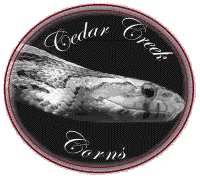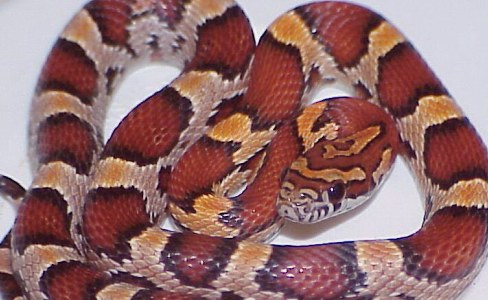
Corn Snake Care Sheet

Common Name :
|
Corn Snake (a.k.a. red rat snake)
|
Scientific Name :
|
Elaphe guttata guttata
|
Range :
|
Southeastern United States
|
Habitat :
|
Heavily forested areas
|
Hatchling Size :
|
Approximately 8 to 10 inches at hatching
|
Adult Size :
|
Average 3 to 4 feet (Range 2 1/2 to 6 feet)
|
Introduction
Corn snakes are one of the most hardy and easy keep snakes in captivity. They come in an almost limitless range of colors and patterns with a wide variety of color and pattern mutations. Cornsnakes as a whole are very mild-mannered and easy to tame. They rarely attempt to bite if handled correctly. Always handle gently without grabbing, squeezing, or making quick, sudden movements. Allow the snake to twine through your fingers from hand to hand, don't grab the snake or attempt to hold it still. Corns are a lighter-bodied snake and tend to be fairly active. They enjoy constantly exploring their surroundings when handled.
Perhaps the most important thing you can do prior to getting a corn snake is to research FIRST. Explore the internet for care sheets, read and re-read the Corn Snake Manual by Bill and Kathy Love, dive into the corn snake forums on Kingsnake.com and Cornsnakes.com and read, read, read. Ask questions, keeping in mind the question may have already been addressed many times over, so scan down the forum and READ. Before you ever bring a snake home, have its new home set up and secure. Know where you are going to be getting your snake's food from. Have temperatures correct and stable. Plan, plan, plan, so that when your new snake comes home, all you have to do is enjoy!
Food
Most cornsnakes are fed a diet of mice and/or rats throughout their lives. Hatchlings start on tiny pinkies (small, 1-3 day old hairless mice) and gradually progress up to large mice or weaned rats. Hatchlings do well being fed every 5 to 7 days, while adults are typically maintained at one feeding every 10 to 14 days. We all have heard 'you are what you eat', so the best way to ensure good nutrition for your snake is to get its food from a good source. It is essential that the mice were fed a high quality diet and kept disease-free in a sanitary environment. Most corn snakes will accept frozen and then thawed pre-killed mice. Not only does feeding frozen-thawed ensure your snake won't be bitten, scratched, or otherwise maimed by it's intended prey, but the ability to store frozen ensures that you always have a ready food supply in the freezer. An additional benefit to frozen-thawed mice is that freezing and then thawing breaks down the integrity of the fibrous tissues in the mouse, making it easier to digest by the snake. Many pet supply stores will sell frozen rodents; they are also available at good prices at local reptile shows and via the internet by rodent suppliers. Kingsnake.com has a large list of suppliers to choose from.
Corn snakes should be fed an appropriately sized food item. A good general rule is not to exceed a prey item wider than 1 and 1/2 times the widest diameter of the snake. Two smaller food items are easier to digest than one larger one. After eating, a corn snake should not be handled for at least 48 hours to give them time to digest. Stressing a snake that has recently eaten may cause them to regurgitate the meal. This is very stressful to the snake and should be avoided if possible.
Water
Clean, fresh water should always be available to your snake in a dish large enough for the snake to curl up in if it so chooses. Some snakes may soak in their water dish to ease shedding or when humidity gets too low. Other snakes may eliminate in their bowls, so regular checks and water changes are a must. Keep the water on the cool end of the tank to slow bacterial growth in standing water.
Corn snakes do best at a lower to moderate humidity. Too high a humidity may predispose to repiratory infections. Too low a humidity and shedding may become more difficult. This can be remedied by offering a humidy box which consists of a box filled with moist paper towels, spagnum moss, or course vermiculite if needed during shedding.
Heating and Lighting
A gradient should be provided within the environment with the cool side at 70 to 75 degrees and the warm side at 80 to 85 degrees. This allows the snake to choose which temperature is best for it at any given time. There are times when a snake needs to be warmer (like during digestion), and other times when it prefers a cooler temperature. Perhaps the easiest and safest way to create a gradient it through the use of a UTH (under tank heater) on the warm side. Most UTH's are too warm and should be controlled with a rheostat to adjust the warm spot to around 85 degrees on the top of the substrate.
Corn snakes do not require UV lighting like many lizards and some snakes, therefore lighting should be chosen which best enhances the coloration of the snake and environment. Gradually increasing duration of lighting ('day length') during the spring and decreasing 'day length' in the fall may help regulate breeders and encourage breeding behavior in the spring.
Substrate
An ideal substrate for a corn snake should be non-abrasive, absorbant, easy to clean, and non-toxic. Substrates to avoid due to toxins include cedar shavings and some pine shavings. Substrates that are not absorbant and therefore promote bacterial growth include sand and gravel. Many reptile owners prefer aspen shavings, which are absorbant, non-toxic, easy to clean, and allow for tunneling (which corns love to do!) Other acceptable substates favored by many include repti-bark (for a natural look), lizard litter (good clumping ability), newspaper (you don't get a more inexpensive substrate!), and astroturf (can be difficult to keep clean). Keep the habitat clean by scooping out soiled substrate as soon as it is noticed. All substrate should be removed and the cage and its furniture completely cleaned periodically.
Cage Requirements
A good rule of thumb for cage size is 1/2 the snakes length in length. A 20 gallon long aquarium is the minimum recommended size for one adult corn snake. Although corn snakes do love to climb, floor space is the most important consideration when discussing tank size. Keep in mind that corn snakes are escape artists, so a secure lid is a MUST. If they can fit their snout through a crack, the rest of the body will follow. Don't risk it, secure the cage ahead of time.
Corns are very secretive in nature, spending a large amount of time in hiding. It is essential for their well-being to have a place to hide and feel secure. Remember to provide hides in the cool AND warm areas so the snake can feel comfortably hidden at its chosen temperature. A piece of bark, a paper towl tube, a simple cardboard box, or a decorative ceramic hides all suffice to provide the seclusion a corn seeks. Choose something that allows the snake to curl up inside without a lot of cavernous space so that it may feel secure.
Breeding
Corn snakes are easy to breed in captivity. It is important to be sure the female is large enough to breed before attempting to do so. Breeding a female too early can lead to egg-binding and other complications resulting possibly in the death of the snake. It is recommended that a female be a MINIMUM of 36 inches in length AND 300 grams in body weight (prior to feeding) before even attempting to breed. This is less critical in males as they don't have to carry and deliver the eggs. Average age at breeding maturity is 3 years of age for females and 2 to 3 years of age for males. Consulting the Corn Snake Manual and other colubrid breeding books is recommended before attempting to breed your snakes. Be prepared to house and raise the young and find homes for them should you choose to breed your corn snakes.